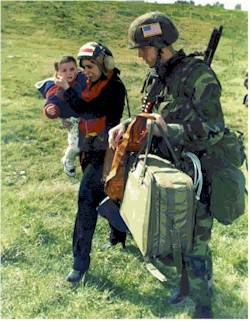Hospital Corpsman Sickcall Screener's Handbook
BUMEDINST 6550:9A
Naval Hospital Great Lakes
1999
Gastrointestinal System
Anatomy: The GI tract functions to provide the body with water, electrolytes, and nutrients. Food is moved through the system while digestive enzymes that break down the food are secreted. The esophagus moves food from the pharynx to the stomach by successive, synchronized contractions. The stomach is found between the esophagus and the duodenum and is shaped like a "J". The food is stored here while hydrochloric acid is secreted and mixed with the food, beginning the digestive process. The partially digested food (called chyme) is pushed into the duodenum through the pyloric sphincter. It is at the beginning of the duodenum that secretions from the pancreas and liver enter via the common bile duct. The liver produces bile that is stored in the gall bladder and released as needed for digestion. The pancreas is located below the stomach and secrets important digestive enzymes. As the food (chyme) moves through the small bowel (jejunum and ileum) nutrient absorption occurs. The large intestine or colon is where water and electrolytes (sodium, potassium, chloride, and bicarbonates) are absorbed.
Undigested material (feces) moves to the rectum where the feces are stored until evacuated.
Abdominal examination:
The abdomen is often divided into four quadrants by imaginary lines crossing at the umbilicus — the RUQ, LUQ, RLQ, and LLQ, (right & left upper and right & left lower quadrants). Three other terms are commonly used — the epigastric, umbilical, and suprapubic regions.
-
Inspection: check for scars, rashes, dilated veins, umbilical hernia or distention.
-
Auscultation: Listen in all four quadrants. An arterial bruit (a vascular murmur like sound) may be heard. Bowel sounds may be present, hyperactive, or absent. If no sounds are heard in five minutes consider them absent.
-
Percussion: Begin percussing the liver down from the right upper chest. Liver dullness begins around the 5th or 6th rib extending down to the costal (rib) margin. Liver length is usually less than 15 cm.
-
Palpation: Feel both superficially (lightly) and deeper in all quadrants with the patients knees bent to relax the abdominal wall.
RUQ: Feel for the liver during inspiration, usually not felt but may be felt in a slender person. If enlarged you will feel the edge of the liver as it passes beneath the fingers.
LUQ: feel for the spleen on inspiration, usually not palpable.
RLQ and LLQ: Check for tenderness (pain increased by pressure). Check for involuntary guarding (tightness of the abdomen), and for rebound tenderness by quickly releasing pressure from the abdomen. Check for peritoneal irritation using the heel tap and pelvic shake.
-
Abdominal Reflex: The abdominal skin is stroked in each of the quadrants. The umbilicus should twitch towards the quadrant, which was stroked.
-
Rectal Exam: With the patient standing while bending at the waist or curled on his/her side and using a glove and lubricant, slowly insert your index finger. Check the prostate anteriorly and obtain a stool specimen for blood and test using the hemacult test.
-
The Routine Abdominal Examination:
-
Inspect abdomen
-
Ausculate all four quadrants
-
Percuss out liver size
-
Palpate for enlarged liver
-
Rectal examination for blood in stool.
GASTROINTESTINAL AND ABDOMINAL PROBLEMS
|
 |
|
Operational Medicine CD
Text, images,
videos and manuals
The essential text for military healthcare providers
www.brooksidepress.org |
Esophageal Reflux: After food has entered the stomach, if the lower esophageal sphincter fails to close adequately. The stomach contents mixed with hydrochloric acid backs up (reflux) into the lower esophagus causing pain and heartburn.
S: Heartburn, burping, regurgitation — worse with lying down, frequently severe substernal pain, occurring 30 — 60 minutes after eating.
O: The physical exam is usually normal. Stool should be checked for occult blood with rectal exam.
A: Esophageal Reflux.
P: Weight reduction if obese, avoid eating near bedtime, Antacids after meals and at bedtime, avoid cigarettes, alcohol, coffee, and tight belts. Elevation of the head of the bed with 6 inch blocks also helps. Gastroenteritis: An acute syndrome characterized by inflammation of the stomach and intestinal tract. Usually caused by a viral organism.
S: Nausea, vomiting and diarrhea. Fever headache and abdominal cramps.
O: Fever under 102 F. Minimal abdominal tenderness. Normal to increased bowel sounds. Dehydrated with orthostatic hypotension "positive tilts" (the blood pressure falls when moving to a standing position)
A: Gastroenteritis
P: Rest, clear liquid diet for 24 hours, and no milk. Correct fluid loss orally or with IV’s. If vomiting is severe, control with: Tigan 250 mg q 6 hrs
Tigan injection 250 mg IM
If not improved in 24 hours or if accompanied by high fever and severe diarrhea refer to MO/PA.
Ulcer Disease: Ulceration of the lining of the stomach or duodenum as a result of hyperacidity. Precipitated by stress, diet — alcohol and coffee, drugs —ASA etc., infection, with heredity playing a role also.
S: Epigastric distress 45 — 60 minutes after meals. Pain is frequently burning or gnawing in quality, and may be nocturnal — becoming most severe between midnight and 0200 hrs. Pain is relieved by food or antacids.
O: Epigastric tenderness, occult blood on rectal exam if the ulcer is bleeding. UGI or endoscopy confirms the diagnosis.
A: Ulcer Disease
P: Restriction of coffee, tea, cola, alcohol and cigarettes.
Antacids: 30 ml po 1 and 3 hours after meals and at hs
Cimetidine
(Tagamet) 400 mg po BID or 800 mg po at Hs.
Refer to MO/PA.
-
Constipation: Considered if defecation is delayed for days beyond the patients normal, or if the stools are unusually harzd, dry, and difficult to move.
S: Constipation, occasionally with abdominal distention or cramps. Usually no severe pain, nausea, vomiting or blood in stools.
O: Minimal abdominal tenderness, usually LLQ, normal bowel sounds, may be able to palpate stool in colon. No blood on rectal exam.
A: Constipation.
P: Diet: increase intake of water and fiber (fruits, bulky vegetables, and bran cereals).
Establish a time for defecation: 15 — 20 minutes following breakfast provides a good time because spontaneous colonic motility is greatest at this time.
Daily exercise.
Metamucil 2 tsp. in water or juice 2 —3 x qd
Milk of Magnesia 2 tsp. at hs
Bisacodyl (Dulcolax) 10 — 15 mg orally or suppository one rectally at hs
Fleets enemas
Diarrhea: Frequent passage of unformed watery bowel movements. May be due to viral, bacterial or parasitic infections. With simple diarrhea no blood, pus, or fever is present. S: Frequent loose or watery stools, mild crampy abdominal pain prior to bowel movement
O: Fever is usually absent, generalized abdominal tenderness, hyperactive bowel sounds, no rebound or localized findings and no blood on rectal exam.
A: Simple diarrhea.
P: Withhold food for 24 hrs — clear liquid diet only. No milk for 3 days.
Kaopectate liquid: 2 tbs. after each loose bowel movement (or 2 tbs.).
Refer to MO/PA if not improved.
-
Hemorrhoids: A mass of dialated, tortuous veins (varies) in the anal area involving the venous network (Plexus) of the area. Caused by straining at stool, constipation prolonged sitting and a diet poor in fiber.
S: Itching, irritation and bleeding with bowel movements.
O: Obvious external hemorrhoid or internal hemorrhoids found on rectal examination.
A: Hemorrhoids
P: High roughage/ fiber diet. Sitz bath (sitting in warm water reduces pain and swelling)
Metamucil
2 tsp. in water 2-3 x qd
Hydrocortisone cream
1%, 2-3 x qd
Anusol or Anusol HC suppositories for internal hemorrhoids given tid.
Note: A thrombosed external hemorrhoid is caused by rupture of a vein, forming a clot in the subcutaneous tissue. A tender, bluish mass is seen. If discomfort is severe and the patient is seen in the 1st 24 hrs, removal of the clot is indicated for pain relief. After 24-48 hrs, hot sitz baths are used.
Refer to MO/PA as indicated.
-
Cholelithiasis (Gall Stones): Formation of calculi or bile stones in the gallbladder.
S: Nausea, vomiting, abdominal pain RUQ, and fever
O: RUQ tenderness, rebound pain, may have jaundice.
A: Gall Stones.
P: Refer to MO/ PA
-
Acute Abdomen: An abnormal condition of the abdomen in which there is sudden onset of severe pain. It requires immediate evaluation and often immediate surgical intervention.
S: Abdominal pain:
-
APPENDICITIS — mild pain gradually increasing usually signifies an infectious process.
-
PERFERATION — sudden severe pain
-
OBSTRUCTION — severe pain coming in waves.
All may have nausea, vomiting, and anorexia.
O: Location of abdominal tenderness is important in diagnosis of the problem (see diagram).
Appendicitis: Right lower quadrant
Perforated Ulcer: Epigastric pain radiating to the
Back Cholecystitis: RUQ pain radiating to shoulder or back
Kidney Stone: Flank pain radiating into the groin
May also have associated fever and elevated lab values.
A: Acute Abdomen
P: Refer to MO/PA
-
Appendicitis: The most frequent cause of acute abdomen.
S: Initially anorexia and pain in the epigastric or periumbilical area of the abdomen. Nausea, diarrhea, and vomiting " may" accompany pain. The pain is moderately severe and after several hours moves to the RLQ and becomes sharper. Fever may be present.
O: Fever if present usually below 101 F. Tenderness in epigastric area, but classically localized to the RLQ. Pain in the RLQ will increase on straight leg raising, or jarring of the right leg with heeltap (positive psoas sign). The actions indicate peritoneal inflammation.
Lab Studies: WBC count is elevated with an increase in
polymorphonuclear leukocytes
U/A is normal,
if positive for blood consider kidney stone
if positive for pyuria (TNTC WBC’c = Pus) consider pyelonephritis
A: Appendicitis
P: Nothing by mouth except occasional sips of ice water.
Refer to MO/PA
|
|
Approved for public release;
Distribution is unlimited.
The listing of any non-Federal product in this CD is not an endorsement of the
product itself, but simply an acknowledgement of the source.
Bureau of Medicine and Surgery
Department of the Navy
2300 E Street NW
Washington, D.C
20372-5300 |
Operational Medicine
Health Care in Military Settings
CAPT Michael John Hughey, MC, USNR
NAVMED P-5139
January 1, 2001 |
United States Special Operations
Command
7701 Tampa Point Blvd.
MacDill AFB, Florida
33621-5323 |
*This web version is provided by
The Brookside Associates Medical Education Division. It contains
original contents from the official US Navy NAVMED P-5139, but has been
reformatted for web access and includes advertising and links that were not
present in the original version. This web version has not been approved by the
Department of the Navy or the Department of Defense. The presence of any
advertising on these pages does not constitute an endorsement of that product or
service by either the US Department of Defense or the Brookside Associates. The
Brookside Associates is a private organization, not affiliated with the United
States Department of Defense.
Contact Us · · Other
Brookside Products

|
|
Operational Medicine 2001
Contents
|

|
 |
|
FMST Student Manual Multimedia CD
30 Operational Medicine Textbooks/Manuals
30 Operational Medicine Videos
"Just in Time" Initial and Refresher Training
Durable Field-Deployable Storage Case |
|





